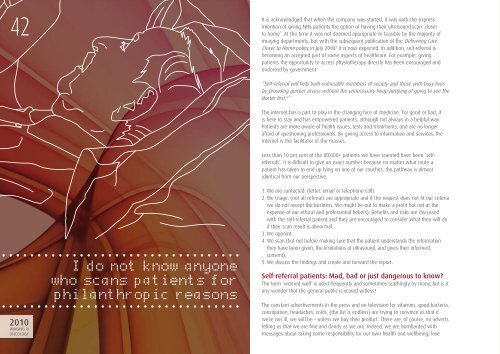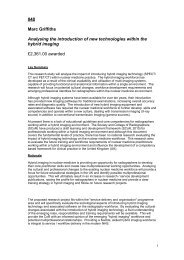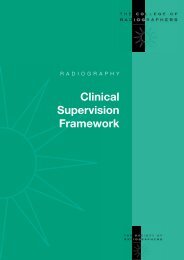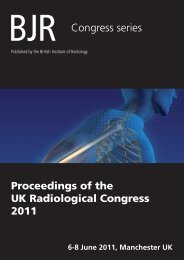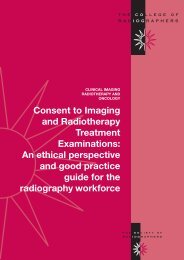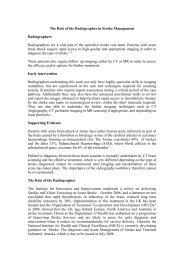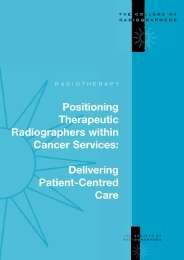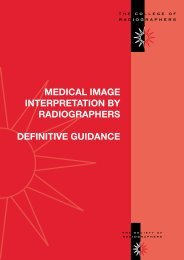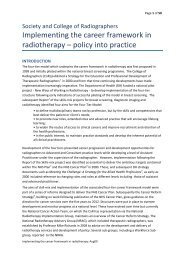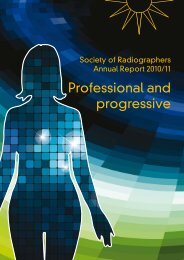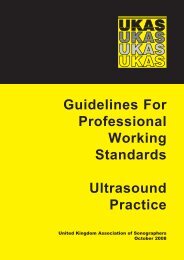42It is acknowledged that when the company was started, it was with the expressintention <strong>of</strong> giving NHS patients the option <strong>of</strong> having their ultrasound scan ‘closerto home’. At the time it was not deemed appropriate or feasible by the majority <strong>of</strong>imaging departments, but with the subsequent publication <strong>of</strong> the Delivering CareCloser to Home policy in July 2008 3 it is now expected. In addition, self-referral isbecoming an accepted part <strong>of</strong> some aspects <strong>of</strong> healthcare. For example, givingpatients the opportunity to access physiotherapy directly has been encouraged andendorsed by government:“Self-referral will help both vulnerable members <strong>of</strong> society and those with busy livesby providing quicker access without the unnecessary hoop-jumping <strong>of</strong> going to see thedoctor fi rst. 4 ”The internet has a part to play in the changing face <strong>of</strong> medicine. For good or bad, itis here to stay and has empowered patients, although not always in a helpful way.Patients are more aware <strong>of</strong> health issues, tests and treatments, and are no longerafraid <strong>of</strong> questioning pr<strong>of</strong>essionals. By giving access to information and services, theinternet is the facilitator <strong>of</strong> the masses.Less than 10 per cent <strong>of</strong> the 80,000+ patients we have scanned have been ‘selfreferrals’.It is diffi cult to give an exact number because no matter what route apatient has taken to end up lying on one <strong>of</strong> our couches, the pathway is almostidentical from our perspective.2010<strong>IMAGING</strong> &<strong>ONCOLOGY</strong>I do not know anyonewho scans patients forphilanthropic reasons1. We are contacted: (letter, email or telephone call).2. We triage: (not all referrals are appropriate and if the request does not fi t our criteriawe do not accept the business. We might be out to make a pr<strong>of</strong>i t but not at theexpense <strong>of</strong> our ethical and pr<strong>of</strong>essional beliefs). Benefi ts and risks are discussedwith the self-referral patient and they are encouraged to consider what they will doif their scan result is abnormal.3. We appoint.4. We scan (but not before making sure that the patient understands the informationthey have been given, the limitations <strong>of</strong> ultrasound, and gives their informedconsent).5. We discuss the fi ndings and create and forward the report.Self-referral patients: Mad, bad or just dangerous to know?The term ‘worried well’ is used frequently and sometimes scathingly by many, but is itany wonder that the general public is scared witless?The constant advertisements in the press and on television for vitamins, good bacteria,constipation, headaches, colds, (the list is endless) are trying to convince us that ifwe’re not ill, we will be – unless we buy their product. There are, <strong>of</strong> course, no advertstelling us that we are fi ne and dandy as we are. Indeed, we are bombarded withmessages about taking some responsibility for our own health and wellbeing; lose
weight, exercise, stop smoking, don’t drink, don’t eat, do eat, have safe sex. Everyweek, newspapers and magazines run terrifying articles about how some diseases donot present with any symptoms until it is too late. Given all this, why is it so wrongfor a woman to arrange a scan to check her ovaries? Does that make her mad or badwhen all she is doing is trying to take some responsibility?How can being concerned about one’s own health be a bad thing? Surely preventionis better (and cheaper) than cure. We are sending the general public mixed messages– if you are overweight, drink too much, smoke, do not exercise then you are almostsinglehandedly going to destroy the National Health Service but on the other hand, ifyou try and look after yourself you will be lambasted and treated like a neurotic socialpariah by some.Arguably, the majority <strong>of</strong> patients self-refer because they do not want to waste theGP’s valuable time if it turns out they are worrying needlessly. Few do it because theydo not trust their GP or want to prove him/her wrong, although I have had patientsrequest a scan because they feel their doctor is not taking their concerns seriously and,sadly, all too <strong>of</strong>ten, pathology has been found, which, in some instances, was serious.A recent audit <strong>of</strong> 1000 <strong>of</strong> our patients (GP referrals) showed that 73 per cent did notneed to go on to secondary care because they had a normal scan result and/or couldbe managed in primary care. A normal scan result is just as important as an abnormalresult because, giving the right information about the result and the implications, putsthe patient’s mind at rest and prevents unnecessary visits to the GP. Exactly the sameis true for self-referrals. What is essential however, is that the scan is undertakenby appropriately trained staff with the informed consent <strong>of</strong> the patient and that theclinical signifi cance (or otherwise) <strong>of</strong> the result is explained to them.Undoubtedly, a normal scan can give false reassurance but this situation appliesequally to those who have self-referred as well as to those who have been referred.But by listening and talking to a patient and understanding what it is that is worryingthem and why they have come for a scan, will help to focus the discussion about theresults. It is important that the patient understands that having a scan (self-referred orotherwise) is not a panacea and that the person best placed to advise them is usuallytheir clinician. A responsible and experienced sonographer will always ensure that thepatient is aware <strong>of</strong> the limitations <strong>of</strong> themselves and <strong>of</strong> the modality.So far, I have considered only the companies who provide services to patients whocontact them directly, but there is another type <strong>of</strong> company – those who haveaggressive marketing campaigns and who send out glossy leafl ets with quotes frompeople who would be dead if it was not for the amazing ‘life-saving’ service theyreceived. My mother receives an average <strong>of</strong> one letter a month from a particularcompany and for the last four months has been trying to fi nd out who sold her nameand address to them. She is not happy about this – not least because my usuallysensible father has started to wonder if they should avail themselves <strong>of</strong> this service.His rationale being that this company would not be allowed to send these things topeople if it was not a good idea. We, as imaging pr<strong>of</strong>essionals, should be campaigningto stop the selling <strong>of</strong> databases to companies like this.Interestingly, some GP surgeries seem to be capitalising on the current climate:Recently a friend received a letter from her GP <strong>of</strong>fering her ovarian screening in thesurgery (for a fee) by a private company who would then send the report back tothe GP. Furthermore, a relative <strong>of</strong> mine had the <strong>of</strong>fer <strong>of</strong> accessing self-pay abdominalaortic aneurysm screening in the GP surgery. Again, the letter came from the surgeryand, on investigation, the surgery received a ‘cut’ <strong>of</strong> that fee. Therefore, it is ratherhypocritical <strong>of</strong> some clinicians to complain about the time taken up by the ‘worriedwell’ demanding appointments to discuss the fi ndings <strong>of</strong> their screening scan whensome <strong>of</strong> them seem to be making money out <strong>of</strong> such services. Once again the Gospel<strong>of</strong> John springs to mind.Obstetric scanningSome private companies suggest that having a 3D scan will help you bond with yourbaby, the inference being that without a 3D scan you may not, which is a ridiculousconcept. However, having a scan later in pregnancy with or without the 3D images,may add to the bonding experience and make what many fi nd an already magicaltime even more special. Sometimes the pressures placed on those undertakingroutine obstetric scanning in the NHS can rob them <strong>of</strong> the ability to see these scansas anything other than routine and that manifests itself in apparent disinterest – acomment made by many <strong>of</strong> our private patients; the excitement and wonder <strong>of</strong> theirpregnancy is turned into the mundane.Women self-refer for obstetric scans for a raft <strong>of</strong> reasons and it is therefore unwise tomake sweeping statements, demonising all providers and the women themselves.There are aspects <strong>of</strong> services provided by some companies which I fi nd distasteful.Selling packages that focus more on the teddy bear/key ring/photo frame/DVDwith your choice <strong>of</strong> music, than on the scan and its fi ndings doesn’t sit well with me,but we live in a democracy where people can choose what they buy. If a womanwants her baby’s fi rst teddy to be a ‘freebie’ form <strong>of</strong> advertising that is up to her. Ifsonographers are happy to sell their skills and experience to provide entertainment, itis up to them – at the moment and in the absence <strong>of</strong> legislation.We have women contacting us to book a 3D scan who say they are not botheredabout having their baby checked because they just want the pictures and/or DVD. Forus, it is not business at all costs and we do not provide services for those people, butthere are companies out there who will. We have had verbal abuse because we haverefused to scan to determine gender before 24 weeks ‘because I don’t want anothergirl’. We do not accept those bookings either. In reality, these requests are few and farbetween. The majority <strong>of</strong> our self-referral obstetric patients come to us (and I assumetherefore to most other independent providers) because they cannot get what theywant, or feel they need, through the NHS.432010<strong>IMAGING</strong> &<strong>ONCOLOGY</strong>


